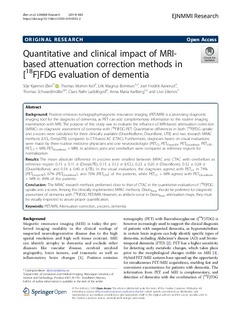| dc.description.abstract | Background
Positron emission tomography/magnetic resonance imaging (PET/MRI) is a promising diagnostic imaging tool for the diagnosis of dementia, as PET can add complementary information to the routine imaging examination with MRI. The purpose of this study was to evaluate the influence of MRI-based attenuation correction (MRAC) on diagnostic assessment of dementia with [18F]FDG PET. Quantitative differences in both [18F]FDG uptake and z-scores were calculated for three clinically available (DixonNoBone, DixonBone, UTE) and two research MRAC methods (UCL, DeepUTE) compared to CT-based AC (CTAC). Furthermore, diagnoses based on visual evaluations were made by three nuclear medicine physicians and one neuroradiologist (PETCT, PETDeepUTE, PETDixonBone, PETUTE, PETCT + MRI, PETDixonBone + MRI). In addition, pons and cerebellum were compared as reference regions for normalization.
Results
The mean absolute difference in z-scores were smallest between MRAC and CTAC with cerebellum as reference region: 0.15 ± 0.11 σ (DeepUTE), 0.15 ± 0.12 σ (UCL), 0.23 ± 0.20 σ (DixonBone), 0.32 ± 0.28 σ (DixonNoBone), and 0.54 ± 0.40 σ (UTE). In the visual evaluation, the diagnoses agreed with PETCT in 74% (PETDeepUTE), 67% (PETDixonBone), and 70% (PETUTE) of the patients, while PETCT + MRI agreed with PETDixonBone + MRI in 89% of the patients.
Conclusion
The MRAC research methods performed close to that of CTAC in the quantitative evaluation of [18F]FDG uptake and z-scores. Among the clinically implemented MRAC methods, DixonBone should be preferred for diagnostic assessment of dementia with [18F]FDG PET/MRI. However, as artifacts occur in DixonBone attenuation maps, they must be visually inspected to assure proper quantification. | nb_NO |

